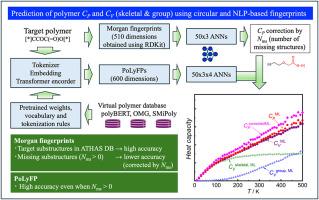Machine learning prediction of heat capacity of polymers as a function of temperature
IF 4.5
2区 化学
Q2 POLYMER SCIENCE
引用次数: 0
Abstract
Machine learning models were developed using the high-quality ATHAS (Advanced Thermal Analysis System) data bank to predict the constant-pressure heat capacity (CP) of polymers at 10 K intervals from 10 to 500 K. Molecular fingerprints (FPs) were used as features; specifically, circular Morgan fingerprints with a bond diameter of 4 derived from the repeating structural units of polymers. For polymers contained in the ATHAS data bank (e.g., polypropylene and polyamide 6), the predicted CP values showed mean relative errors (MREs) within ±3%. In contrast, for polymers absent from the data bank—including poly(p-dioxanone), poly(N-vinylpyrrolidone), and starch—a positive correlation was observed between MRE and the number of missing substructures (Nms), defined as hashed identifiers present in the target polymer but absent from the ATHAS-derived feature space. Using this correlation, CP predictions for polymers with Nms > 0 were adjusted, reducing the MREs to within ±3%. To improve accuracy, additional models employing alternative FPs were built: polyBERT FP, generated from a pre-trained BERT-based chemical language model, and OMG FP and SMiPoly FP, derived from the virtual polymer libraries OMG and SMiPoly. For polymers with Nms > 0, all alternative FPs yielded lower MREs than uncorrected Morgan fingerprints. The lowest MREs were achieved using a hybrid FP constructed from OMG and 10% of the SMiPoly dataset, demonstrating enhanced extrapolative performance. Due to computational limits, molecular dynamics struggles to capture this temperature dependence, whereas trained machine learning models may rapidly predict it for many polymers, suggesting their potential as a practical alternative.

机器学习预测聚合物的热容量作为温度的函数
使用高质量的ATHAS(高级热分析系统)数据库开发机器学习模型,以预测聚合物在10至500 K的10 K间隔内的恒压热容(CP)。分子指纹(FPs)作为特征;具体来说,键直径为4的圆形摩根指纹来自于聚合物的重复结构单元。对于ATHAS数据库中包含的聚合物(例如聚丙烯和聚酰胺6),预测CP值的平均相对误差(MREs)在±3%以内。相比之下,对于数据库中缺失的聚合物,包括聚(对二氧环酮)、聚(n -乙烯基吡咯烷酮)和淀粉,MRE与缺失亚结构(Nms)的数量呈正相关,Nms被定义为存在于目标聚合物中但不存在于athas衍生的特征空间中的散列标识符。利用这种相关性,对nms>; 0聚合物的CP预测进行了调整,将MREs降低到±3%以内。为了提高准确性,我们还构建了其他使用替代FPs的模型:polyBERT FP,由预训练的基于bert的化学语言模型生成,OMG FP和SMiPoly FP,源自虚拟聚合物库OMG和SMiPoly。对于具有Nms >; 0的聚合物,所有替代FPs产生的MREs都低于未校正的Morgan指纹。使用由OMG和10%的SMiPoly数据集构建的混合FP实现了最低的MREs,展示了增强的外推性能。由于计算的限制,分子动力学很难捕捉这种温度依赖性,而训练有素的机器学习模型可以快速预测许多聚合物的温度依赖性,这表明它们有可能成为一种实用的替代方案。
本文章由计算机程序翻译,如有差异,请以英文原文为准。
求助全文
约1分钟内获得全文
求助全文
来源期刊

Polymer
化学-高分子科学
CiteScore
7.90
自引率
8.70%
发文量
959
审稿时长
32 days
期刊介绍:
Polymer is an interdisciplinary journal dedicated to publishing innovative and significant advances in Polymer Physics, Chemistry and Technology. We welcome submissions on polymer hybrids, nanocomposites, characterisation and self-assembly. Polymer also publishes work on the technological application of polymers in energy and optoelectronics.
The main scope is covered but not limited to the following core areas:
Polymer Materials
Nanocomposites and hybrid nanomaterials
Polymer blends, films, fibres, networks and porous materials
Physical Characterization
Characterisation, modelling and simulation* of molecular and materials properties in bulk, solution, and thin films
Polymer Engineering
Advanced multiscale processing methods
Polymer Synthesis, Modification and Self-assembly
Including designer polymer architectures, mechanisms and kinetics, and supramolecular polymerization
Technological Applications
Polymers for energy generation and storage
Polymer membranes for separation technology
Polymers for opto- and microelectronics.
 求助内容:
求助内容: 应助结果提醒方式:
应助结果提醒方式:


